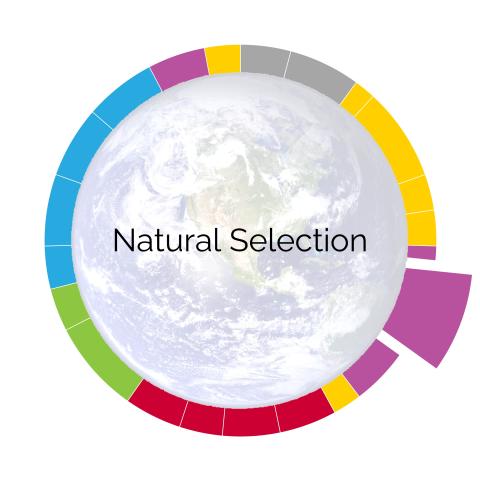Thanks for your interest in the MBER curricular resources. Here we provide a preview of our Natural Selection unit, as well as some additional information about our design and pedagogical commitments. Browse the page below. This "model triangle page" contains all you would need to teach the Natural Selection unit. Such a page exists for each of the 2o units in the MBER Living Earth full-year sequence.
One you've spent some time understanding how an MBER unit looks, consider joining as a member and gain full access to the remainder of the curriculum, our pedagogical supports and a community of teachers interested in bringing a robust modeling and sensemaking practice into their classrooms.

Phenomenon
We see that traits change in populations over time through examination of peppered moths in England, bacteria in a story of antibiotic resistance, and most extensively through exploration of a population of Darwin's finches in the Galapagos.
Question
Why do traits change over time in these populations? And how does it work?
Model Ideas
The following ideas are the basis of Darwin's model of natural selection. Your classroom model may look different as kids generate their own language for the same series of explanatory ideas.
1. Populations have the potential to grow exponentially but they typically don't because of limited resources or environmental factors.
2. Variation in traits naturally exists in populations.
3. Depending on the environment, traits can be advantageous or disadvantageous.
4. Individuals with more advantageous traits are more likely to survive, and therefore, can reproduce.
5. Many traits are heritable, so offspring tend to resemble their parents.
6. In each generation the number born with the advantageous trait will increase and the number with the disadvantageous trait will decrease.
7. Over time the distribution of traits in the population will change.
Overview
In the previous unit (Unity & Diversity), students generated some ideas about the breadth of diversity of life on Earth and the remarkable similarities that we see across species.
In this triangle, Natural Selection, we present students with phenomena of population change, motivating students to work to explain how traits change over time. Through a data-driven activity focused on Galapagos Ground Finches, students generate a narrative that reveals their initial model for natural selection. In engaging with a series of investigative phenomena (games, simulations, readings), they both deepen and revise their understanding, moving toward a set of ideas in the classroom that is strikingly similar (though not identical) to models synthesized by Charles Darwin and Ernst Mayr. After coming to consensus regarding which ideas they have been able to support, they "finalize" the class model and go on to apply it to a novel scenario.
Following this unit, students expand their model for Natural Selection by wondering how biodiversity more broadly changes over longer stretches of time.
Advanced Planning
This unit includes a number of activities and labs. You'll want to prepare the data-rich activity in Learning Segment 04 well in advance. (Students examine three years of data about finch populations on Daphne Major.) Though it only requires making photocopies, you'll need to decide how to present the activity to your particular student population. In Learning Segment 06, there are a number of activities that move the class to explore their initial ideas more carefully. One simulation requires access to electronic devices that can handle running the program NetLogo. (See teacher guide for the activity, located in the zip file at the bottom of this page.) Both the variation lab and Wormeaters activity require the purchase of supplies (available at your local grocery/general store) and some degree of set up, as does the card sort activity later in the lesson sequence. See the Advanced Planning resources in MBER Essentials for a full list of needed supplies.
Download Resources
| Attachment | Size |
|---|---|
| All Other Resources for Natural Selection | 51.48 KB |
| Natural Selection PowerPoint (and embedded Teacher Manual) | 132.29 KB |